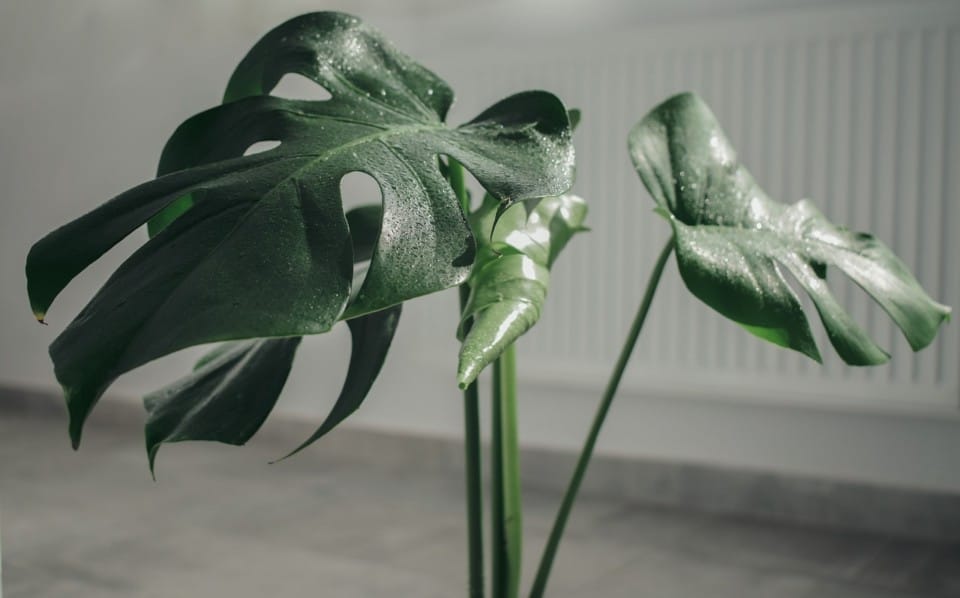Some links in the post are affiliate links and I get a commission from purchases made through some links found in the post.
Monstera deliciosa, also known as the Swiss cheese plant or split-leaf philodendron, is a flowering plant found in the forests of southern Mexico and south to Panama.
The term Monstera deliciosa is derived from two words, “Monstera” (means monstrous or abnormal) and “deliciosa” (means delicious), referring to edible fruit.
The name “Swiss cheese plant” is given because the leaves of this plant are broad and have numerous holes, giving it the appearance of Swiss cheese.
Do Monstera Plants like to be Root Bound?
 When a plant can grow out of its container, and its roots wrap around itself, it is said to be root bound.
When a plant can grow out of its container, and its roots wrap around itself, it is said to be root bound.
Unfortunately, monstera deliciosa can also become root-bound, and when grown in a container inside a house or a nursery, its roots wrap around themselves and leave no room or space for the air, nutrients, and water, causing stunted growth or even death in a worst-case scenario.
Due to this happening you can tell a monstera plant does not like to be root bound.
Monstera deliciosa has an excellent growth capacity, and it can grow up to 12 feet tall.
So, if it is grown in a small pot or container, it will not grow freely and will result in stunted growth of the plant.
To reach its full growth capacity, it should be allowed to grow freely in large containers with more than enough space to prevent root bounding.
If you are enjoying this article, check out our article on why are my monstera leaves not splitting
When to Repot a Monstera?
Monstera deliciosa needs specific temperature, humidity, and soil content for proper growth. It needs an 18-degree Celsius temperature, moderately moist soil, and a highly humid environment to grow properly.
Moreover, it needs adequate support in the form of a wooden stake in the middle of the container to reach its full growth capacity.
If the plant is young, you should repot your monstera every year to enhance its growth capacity and freshen the soil.
If it is observed that the plant is root bound, you need to repot your monstera. For this purpose, remove the plant out of the container and observe whether the roots are coiling around themselves or not.
It is not always necessary to remove the plant from the container. If the drainage hole at the bottom of the container or planter shows roots or the water is seeping out, it is an indication that you need to repot your monstera.
If one does not need to replace the pot or the container, one should prune the roots to create some space for the plant’s growth. Then, the soil can be replaced, and the plant can be grown in the same container.
The best time to repot a Monstera plant is the early spring, as it gives ample time and suitable conditions to the plant to grow as much as possible throughout the warm season.
How to Repot a Monstera Plant?
As the Monstera plant is a flowering plant that grows in tropical forests, it requires nutrient-rich soil that can hold enough water for its as per the growth requirement of the plant.
Therefore, a fine quality potting soil with the addition of some peat moss is required.
The container or the pot should have plenty of fine holes at the bottom of the container, and the depth of the container should be deep enough to accommodate the entire length of the plant.
Fill the bottom third of the container with soil and set the plant at the center of the container for proper support. If the plant is tall and already matured, the second support set is required to hold it.
Set the base of the plant in the planter in such a manner that the original soil line is just below where the original line will be.
Ensure proper filling around the roots and the aerial roots. To attach the stakes with the plant, use the plant ties. There you have it, you have now repotted a monstera.
You may also like: How to care for a monstera
How to Repot Monstera with a Pole and a Moss Pole?
Split-leaf philodendron is an epiphyte, i.e., it grows vertically by using the support of other plants or trees in the environment.
For this purpose, Monstera can be trained to grow on a moss pole. As this plant grows vertically up to 12 feet in height, it requires a stake that is a bit longer than the length of the plant and is strong enough to hold the plant as its stem is quite heavy.
Make the use of fire snips and cut a piece of fine wire mesh to be wrapped around the stake.
To attach the mesh with the stake, wooden staplers can be used. Filling around the stake is done with the help of sphagnum moss, pushing it into the mesh.
Moss poles can also be made without the use of stake, but these are relatively less stout than those with the stakes. Make a tube with the mesh, fill it with the moss and tie the edges together to make these poles.
Using the moss poles for Swiss cheese plants creates an excellent scaffold for the upright growth of the plant as the stem is so strong that if it is not supported by the moss poles, it will cause bending of the plant over the side and will eventually trail on the ground.
It can also prove damaging for the stems by putting strain on them. This training is necessary to maintain the correct posture and needs to be repeated two to three times a year.
If you are enjoying this article, you might find our article on why is my monstera drooping interesting.
Care needed for maintaining proper growth of the Monstera deliciosa Plant?
Water
Generally, it is a practice to let the plant dry before watering it, as overwatering is more detrimental than underwatering.
In the case of Monstera, dry conditions are harmful as this plant requires special conditions like high humidity for proper growth and maintenance. Therefore, watering it once a week serves the purpose.
If humidity is low, these plants can dry out, and their leaf edges turn brown. So, avoid placing the plant near a heater and promote the use of mists and humidifiers.
If the humidifier is not available, other methods can also provide a moist environment. For example, place the plants in a sink and run water all over them. It will thoroughly hydrate the plant.
Light
When the Swiss cheese plant is exposed to direct sunlight, it turns harmful and turns the color of the foliage yellow.
As this plant is an understory plant and lives below the rain forest canopy, it requires indirect or filtered sunlight for flourishing.
Fertilizers
 The Split-leaf philodendron will develop bigger and better leaves if provided with a continuous supply of fertilizers with high nitrogenous content.
The Split-leaf philodendron will develop bigger and better leaves if provided with a continuous supply of fertilizers with high nitrogenous content.
The fertilizers commonly used for plants have a combination of nitrogen, phosphorus, and potassium. It is labeled as “N-P-K” on the fertilizer product.
The numerical numbers next to each alphabet indicate the ratio of each content present in the fertilizer. Ideally, the ratio should be “3:1:2” or “3:1:3”. Following are the functions of each content that is present in the fertilizer:
- Nitrogen is responsible for the reproductive, non-flowering, or vegetative growth of the plant that is mainly responsible for the shoot formation and giving greenish color to the plant.
- Potassium is mainly responsible for regulating the cellular function of the plant.
- Phosphorus has a role in seed setting, root formation, and flowering in the plant.
The plant is grown for two main purposes. Firstly, it is used to obtain the foliage, and secondly, it is grown to get delicious fruit.
Primarily, it is used to obtain vegetation, and for this purpose, the nitrogenous content should be relatively higher than phosphorus. On the other hand, if the objective is to get fruits, the relative phosphorus concentration should be higher.
Growth Habit
As the Monstera plant is a vine, it will benefit from the support in the form of moss poles with or without the stake and provide a considerable amount of foliage.
Soil
A peat-based mixture with perlite provides favorable soil for Monstera deliciosa. However, replacing the soil is also an essential step in care from time to time.
When the soil becomes saturated, it becomes a breeding space for many bacteria that can hamper the plant’s growth and decay its roots and, eventually, the entire plant.
As the Swiss cheese plant requires humid conditions to grow, it needs soil to absorb water. So, any soil with water-absorbing crystals or added clay can serve the purpose.
The benefit of a peat-based mixture with perlite is that it ensures the provision of the right amount of nutrients and humidity required for the plant’s blooming.
Temperature
The typical home temperature is acceptable during the growing season and a shift to a cooler setting in the winter between 55- and 65-degree Fahrenheit.
Monsteras can only grow properly when a temperature of 65-degree Fahrenheit is achieved along with a highly humid environment.
Monsteras can tolerate much drier climates than the other flowering plants, but when it is allowed to grow indoors, it is better to keep it out of the reach of the heating conditions.
Interestingly thought depending where you live, you can grow your monstera outside. check out our article on can a monstera live outside.
Pruning
If the aerial root becomes untidy and unattractive, this is when pruning should be done. First, Monsteras should be pruned at the leaf node level to leave no stump.
Next, remove all the damaged and dead leaves and stems for a wild look. Healthy and neat aerial roots are essential for supporting the plant and absorbing moisture.
Pest Control
A pest is a destructive insect or another animal that attacks crops, food, or livestock.
Spider mites are tiny, whitish pests that thrive in warm and dry conditions. If webs are observed across the plant, the plant has a spider mite problem.
These insects can suck the inner sap of the plant to fulfill their nutritional requirements, and in return, can harm the plant.
Mealybugs attack the junction of the leaf and the plant’s stem and form the clump of cotton-like mass. It is detrimental to this plant in the same way as the spider mite and sucks the inner sap of the plant.
When treating the spider mites and the mealybugs, quick intervention is required as they attack the Monstera plant and the other plants indoors.
A spray of neem or an insecticidal agent should be given repeatedly from time to time to kill the insects.
Another thing to look out for are thrips, we have an article on how to get rid of thrips on your monstera.
Post-Potting Instructions for Monstera deliciosa
Water the pot deeply after potting the plant. Give a pause of two weeks and then proceed with monthly feeding with the liquid fertilizer during watering.
The Swiss cheese plant may get too big, and in the terrestrial habitat, it grows up to 3 meters tall, and this is too big for the indoors.
However, it can be trimmed regularly, and the cuttings can be kept to grow new plants. The leaves should be cleaned periodically, and the plant should be prevented from spider mite infestation.
This plant with glossy appearing foliage can provide the greenish lacy leaves for an extended period if proper care is guaranteed.
Final Thoughts
 Keep the Monstera plant out of the reach of children and pets in the house. It’s unlikely they would ingest enough portion of the plant to cause a severe allergic reaction, but the calcium oxalate crystals are needle-sharp.
Keep the Monstera plant out of the reach of children and pets in the house. It’s unlikely they would ingest enough portion of the plant to cause a severe allergic reaction, but the calcium oxalate crystals are needle-sharp.
They can cause an intense burning sensation in the mouth, tongue, and throat. If any part of the plant, except the ripe fruit is ingested, it will cause a severe allergic reaction and result in nausea, vomiting, and diarrhea.
The sap can also cause skin irritation in sensitive individuals. For this purpose, one should always wear gloves and goggles while handling the plant.
Always clean the handling instruments with a household cleaner like Lysol to prevent the spread of pests and microorganisms.
Suppose proper care is provided to the Monstera plant, i.e., repot every two to three years, pest control, provision of suitable temperature, humidity, and all other conditions that have been discussed in the article that are mandatory for the normal development of the plant.
In that case, it can survive for years, provide both the fruit and the foliage and serve as decorating stuff that can become the center of attention of the entire house.
About the Author:
Saad Ansar
Saad is an avid gardener himself and is a great lover of plants, animals, photography, & people. Currently, he is focused on photographing indoor plants & captioning beautiful outdoor sceneries. In addition, he writes and rewrites in-depth articles on nature and science.


